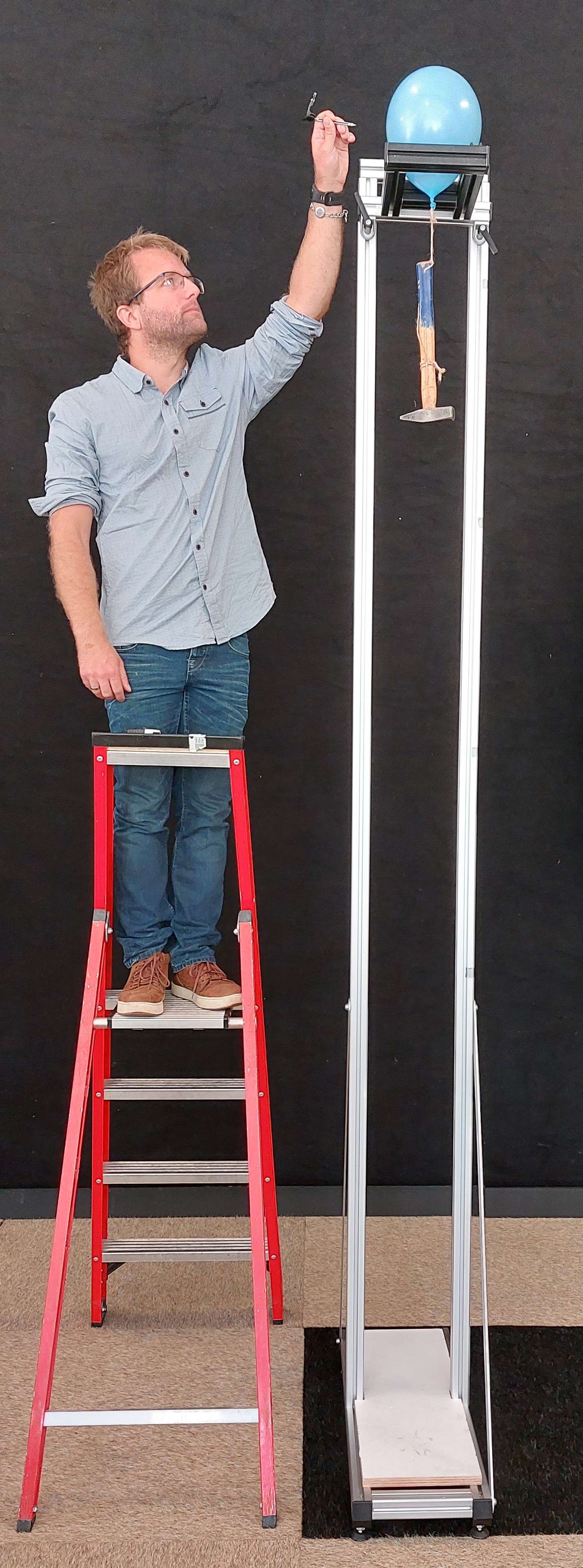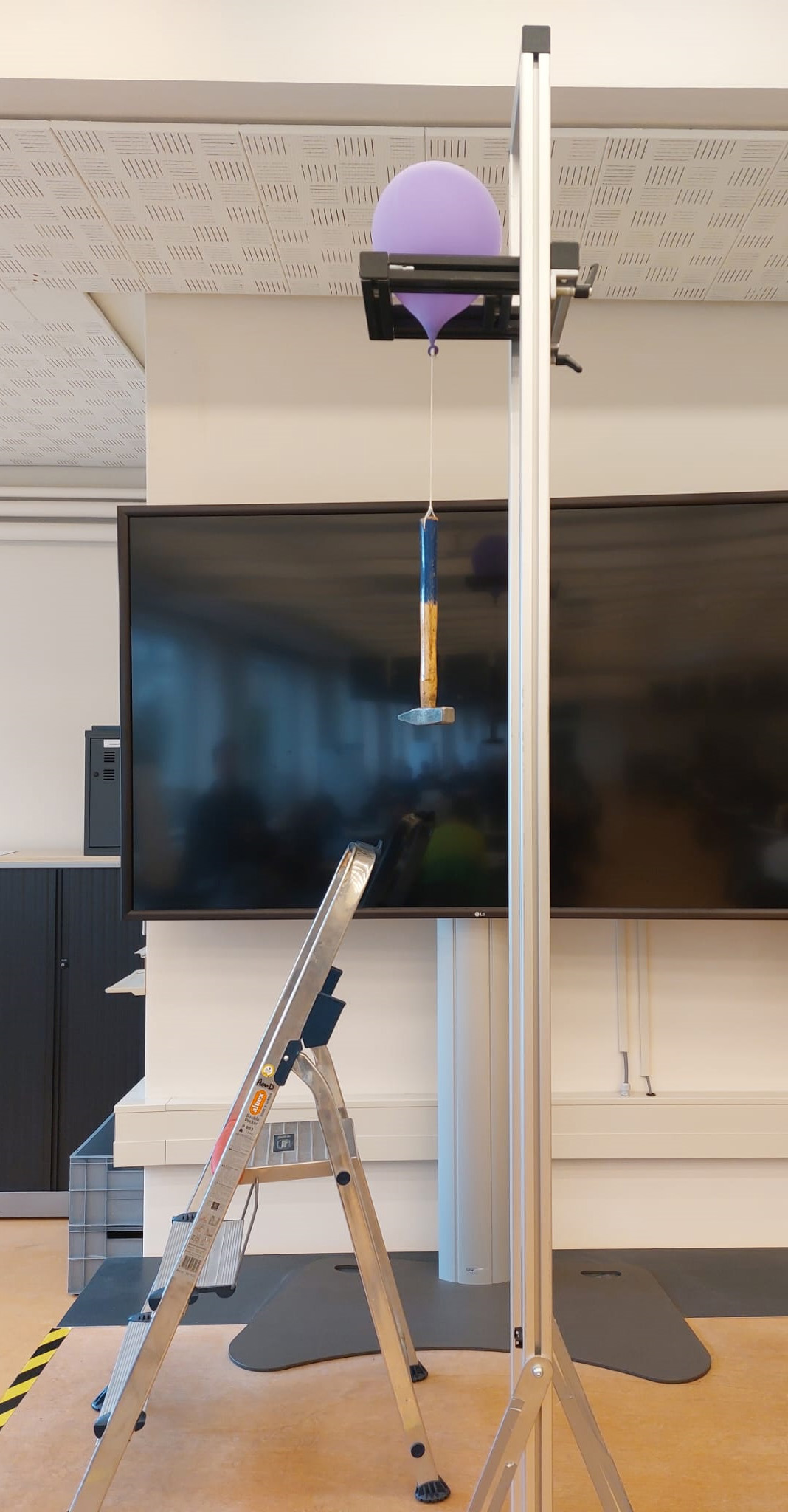14.11. Determination of g#
But with precision!
| Author: | Freek Pols |
| Time: | 20 minutes |
| Age group: | 14 - 18 |
| Concepts: | Measurement, accuracy, gravitational acceleration, uncertainty |

Fig. 14.22 The hammer is suspended at a great height with a string attached to a balloon.#
Introduction#
In many ways you can experimentally determine the acceleration due to gravity. But how good is the result? What should you pay attention to if you want to make a very accurate determination? How do you quantify the accuracy with which you have determined the gravitational acceleration? This demonstration evolves around the question how we can setup an accurate experiment. The most important learning goal here is that it usually takes more time to set up the experiment than it takes to acquire the data.
Equipment#
Fully inflated balloon
Hammer
Phone with phyphox app
String
Wooden plank
Framework for the setup
Needle
Measuring tape
Preparation#
Inflate the balloon and hang the hammer with a string from the balloon. Hang the whole setup on the framework and ensure the wooden plank is directly beneath the hammer. Use the acoustic chronometer in the Phyphox app with a threshold value of 0.35 and a delay of ~0.3 s.

Fig. 14.23 The experimental setup.#
Procedure#
Start the demonstration by discussing what an accurate measurement entails and why an accurate value of \(g\) can be important. Explain the experiment: With a single measurement and using the equation \(H= \frac{1}{2}gt^2\) , we will determine \(g\) as accurately as possible. Popping the balloon starts the acoustic chronometer, and the hammer’s BANG on the ground stops the timer.
Is it necessary for a good measurement to have the largest or smallest possible falling height? Are there any conditions on the extreme values you choose?
Where should you hold the phone? At the top, bottom, middle, or does it not matter? Why?
How accurate do we measure the time and height?
Have students brainstorm answers to the questions in pairs, write down the answers, and then invite students to share their answers (think, pair, share).
After measuring the falling height (with an estimate for the uncertainty) and determining the fall time, you can start a discussion about the uncertainty in the time measurement. Is it 1.0 s, 0.1 s, 0.01 s, or 0.001 s? Or is it something in between?
Normally, you determine the uncertainty in time by repeating the experiment, but what numbers do you expect to see when you repeat the measurement? Or said differently: Which decimal digit will likely vary?
By using the code provided below, you can calculate the final value of g with its associated uncertainty. Click the rocket at the top of the page to make the Python code cell active.
Physics background#
Every measurement can only be done with a certain precision. Sometimes the precision is determined by the equipment, and sometimes by the property you are measuring. In science, the answer is always given with the associated uncertainty, where the chance that a repeated measurement falls within the value with its associated uncertainty is equal to 68% (\(P(\bar{x}-\mu_x<x<\bar{x}+\mu_x)=0.68\)). When multiple quantities play a role, as in the determination of the acceleration due to gravity, each measurement contributes. The final value of the uncertainty in this equation is given by:
The uncertainty is always given with only one significant figure. The final answer is given with the same decimal digit (e.g., 9.8 ± 0.3 m/s²).
Follow-up#
A nice follow-up is to have students work with one of the various methods to determine g (e.g. with a pendulum, ball with magnetic switch, Ehrlig’s drop method, acceleration along a slope with an air-cushioned track) and present the method (with its pros and cons). The University of Aachen has a video demonstrating this experiment: https://youtu.be/zRGh9_a1J7s.
# Import libraries
import numpy as np
# Record your measurements here. H in cm, dt in s.
H = /100 #measured height in cm
u_H = /100 #the estimated uncertainty in the height
dt = #measured fall time in s (using phyphox)
u_dt = #the estimated uncertainty in the fall time
# Function for determining the acceleration due to gravity
def g(H,dt):
return 2*H/dt**2
print('In this experiment, g is determined to be: ', g(H,dt))
err_in_g = np.sqrt((u_H/H)**2+4*(u_dt/dt)**2)*g(H,dt)
print('In this experiment, g is determined to be: %.1f +/- %.1f m/s^2' %(g(H,dt), err_in_g))
